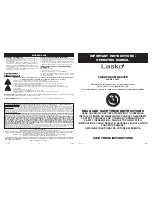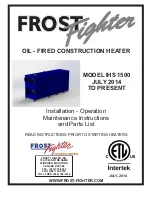
Installing the (OUTDOOR) water heater:
This water heater must be installed in accordance with these instructions, local codes, utility company
requirements and/or in the absence of local codes, use the latest edition of the American National
Standard/National Fuel Gas Code. A copy can be purchased from either the American Gas Association, 400
North Capitol Street Northwest, Washington, DC 20001 as ANSI standard Z223.1 or National Fire Protection
Association, 1 Batterymarch Park, Quincy, MA 02269 as NFPA 54. In Canada, the latest edition of the CSA
B149.1 Natural Gas and Propane Installation, and the Canadian Electrical Code, CSA C22.1 Part 1, in the
absence of local codes.
Location of the OUTDOOR water heater
The water heater shown on the left is for
OUTDOOR installation ONLY!
This water heater is an outdoor model
and must be mounted vertically. It
must not be installed indoors or in a
confined space.
The water heater should be installed
close to the most frequently used outlet
and its position chosen with safety and
service in mind.
Make sure people (particular children,
disabled, and elderly) will not touch the
hot water outlet or the flue terminal.
The flue terminal and air inlet must be
clear of obstruction and shrubbery.
The water heater should not be located
in an area where leakage of the heat
exchanger or connections will result
in damage to the area adjacent to it
or to lower floors of the structure.
A gas fired water heater or any other
appliance should not be installed in
a space where liquids which give off
flammable vapors are to be used or stored.
Such liquids include gasoline, LP gas
(butane or propane), paint or adhesives
and their thinners, solvents or removers.
Because of natural air movement in a
room or other enclosed space, flammable
vapors can be carried some distance from
where their liquids are being used or
stored. The open flame of the water
heater’s main burner can ignite these
vapors, causing an explosion or fire which
may result in severe burns, death or
property damage.
The water heater must be located so it is not
subject to physical damage, for example, by
moving vehicles, area flooding, etc.
l
The water heater should be installed
vertically with the water, gas and power
connections on the underside pointing
toward the ground.
l
Failure to properly install the water heater
outdoors as outlined in this manual can
result in unsafe operation.
l
Hot and cold water lines should be insulated
to conserve water and energy.
l
The water heater and water lines should
be protected from exposure to freezing
temperatures.
l
Do not
install water heater where subject
to vibrations.
l
Do not
install the water heater in
Recreational Vehicles, Mobile Homes,
Boats and other Watercrafts.
l
Do not
install the water heater near
vents for heating or cooling. A minimum
of 4 feet should be maintained.
l
Minimum clearance from combustible
and noncombustible construction is
1/2” (1.3 cm) sides, 0” rear (with support
bracket); 12” (30 cm) from the bottom;
12” (30 cm) from the front of the water
heater; (24” [61 cm] from front
recommended for servicing purposes).
If the clearances stated on the Instruction/
Warning Label, located on the front panel
of the heater differ, install the water
heater according to the clearances stated
on the label.
WARNING: Combustible
construction refers to
adjacent walls and ceilings
and should not be confused
with combustible or
flammable products and
materials. Combustible
and/or flammable products
and materials should never
be stored in the vicinity of
this or any gas appliance.
min.
1/2 "
(1.3 cm)
min.
1/2 "
(1.3 cm)
min. 12" (30 cm)
(24" (61 cm) minimum is
recommended for service)
Front = 12" (30 cm)
Back = 0" (with support bracket)
Side = 1/2" (1.3 cm)
Bottom = 12" (30 cm)
Minimum Clearance from Combustible and
Non-Combustible Construction.
Top: Do not install this water
heater under an overhang less
than 36” (91 cm) from its top.
The area under the overhang
must be open on 3 sides.
7
CAUTION:
Protect plastic, paint or
other items sensitive to heat
using non-combustible
insulation if these are
exposed to the flue exhaust
even though they may be
more than 24” (61 cm) away
from the water heater.








































